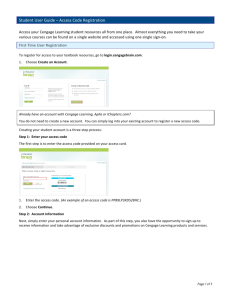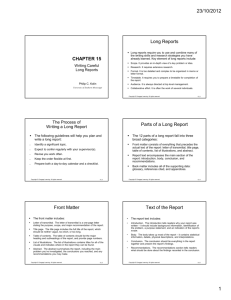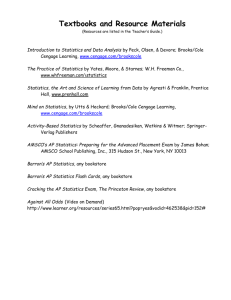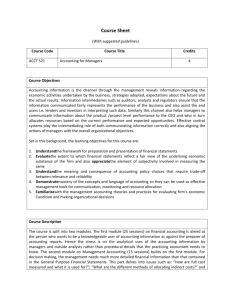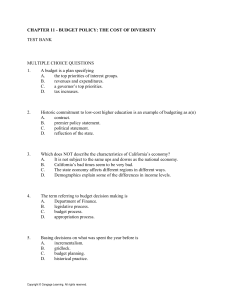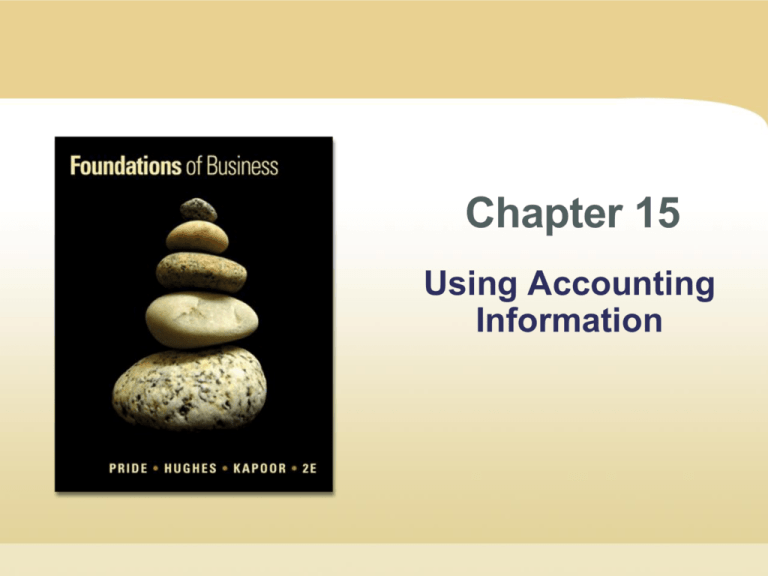
Chapter 15
Using Accounting
Information
Learning Objectives
1. Explain why accurate accounting information and
audited financial statements are important.
2. Identify the people who use accounting information and
possible careers in the accounting industry.
3. Discuss the accounting process.
4. Read and interpret a balance sheet.
5. Read and interpret an income statement.
6. Describe business activities that affect a
firm’s cash flow.
7. Summarize how managers evaluate the financial health
of a business.
Copyright © Cengage Learning. All rights reserved.
Chapter 15 | Slide 2
Accounting
…the process of systematically collecting,
analyzing, and reporting financial information.
Copyright © Cengage Learning. All rights reserved.
Chapter 15 | Slide 3
Accounting Provides Answers
1. How much profit did a business earn last year?
2. How much tax does a business owe
the Internal Revenue Service?
3. How much cash does a business
have on hand?
Copyright © Cengage Learning. All rights reserved.
Chapter 15 | Slide 4
Accounting As an Information System
Source: Needles, Powers, Crosson, Principles of Accounting (Boston: Houghton Mifflin, 2005).
Copyright © Cengage Learning. All rights reserved.
Chapter 15 | Slide 5
Recent Accounting Problems
Pressure to “cook”
the books
Greed: compensation
tied to stock value
Inaccurate/misleading
reporting
Increased SEC and
IRS scrutiny
Copyright © Cengage Learning. All rights reserved.
Chapter 15 | Slide 6
Audited Financial Statements
Audit: Examination of a company’s financial statements
and accounting practices that produced them
Generally Accepted Accounting Principles
(GAAPs): Accepted set of guidelines and practices
for companies reporting financial information and for
the accounting profession
Copyright © Cengage Learning. All rights reserved.
Chapter 15 | Slide 7
Organizations Influencing Accounting Profession
Financial Accounting Standards Board (FASB)
American Institute of Certified Public
Accountants (AICPA)
International Accounting Standards Board
(IASB)
Copyright © Cengage Learning. All rights reserved.
Chapter 15 | Slide 8
Sarbanes-Oxley Act (2002)
SEC established oversight board
CEO/CFO required to certify reports
Accounting firms cannot provide
non-auditing/consulting services
Auditors keep documents/work papers
for 5 years
Prison sentences up to 20 years for
document destruction
Change auditing firm every 5 years
Protection of whistle-blowers
Copyright © Cengage Learning. All rights reserved.
Chapter 15 | Slide 9
Table 15.1: Users of Accounting Information
Managers + outside individuals + other organizations
Copyright © Cengage Learning. All rights reserved.
Chapter 15 | Slide 10
Types of Accounting
Managerial: provides information to make
decisions about financing, investing, and
operations
Financial: generates statements/reports
Cost: determines cost of production
Government: ensures tax revenues collected
Not-for-Profit: accounts for donations
and expenditures
Tax: plans tax strategy and prepares returns
Copyright © Cengage Learning. All rights reserved.
Chapter 15 | Slide 11
To Be Successful in Accounting
Be responsible,
honest, ethical
Have strong background
in financial management
Know computer/software
to process data
Be able to communicate
about accounting
information
Copyright © Cengage Learning. All rights reserved.
Chapter 15 | Slide 12
Spotlight
Income for Accountants and Auditors
Source: The Bureau of Labor Statistics web site at www.bls.gov, May 18, 2009.
Copyright © Cengage Learning. All rights reserved.
Chapter 15 | Slide 13
Accountant Classifications
Private: employed by specific organization
Public: works on fee basis for clients and may
be self-employed
Certified Public Accountant (CPA): individual
has met state requirements for accounting
education and experience and has passed
AICPA exam
Certified Management Accountant (CMA):
certified by Institute for Management
Accountants
Copyright © Cengage Learning. All rights reserved.
Chapter 15 | Slide 14
Requirements for
Becoming a CPA
1. Education = 150 undergraduate and/or graduate
semester hours
2. Most areas
a) At least a bachelor’s degree
b) Two+ years of public accounting (some areas accept
non-public accounting)
c) Certificate and license: pass exam and fulfill
experience
3. Age = 18+
Source: SmartPros, “Basic Information on the CPA Exam”, 2000, http://www.pro2net.com/x14341.xml
Copyright © Cengage Learning. All rights reserved.
Chapter 15 | Slide 15
Accounting Equation
Assets = Liabilities + Owners’ Equity
Assets = Resources Business Owns
Liabilities = Firm’s Debts
Owners’ Equity = Total Assets - Total Liabilities
Copyright © Cengage Learning. All rights reserved.
Chapter 15 | Slide 16
Double-Entry Bookkeeping
…a system in which each financial
transaction is recorded as two separate
accounting entries to maintain the balance
shown in the accounting equation.
Copyright © Cengage Learning. All rights reserved.
Chapter 15 | Slide 17
Accounting Cycle
Analyze
Close
Prepare
Record
Post
Copyright © Cengage Learning. All rights reserved.
Chapter 15 | Slide 18
Balance Sheet
…a summary of the dollar amounts
of a firm’s assets, liabilities, and owners’
equity accounts at the end of a specific
accounting period.
Copyright © Cengage Learning. All rights reserved.
Chapter 15 | Slide 19
Figure 15.1: Personal Balance Sheet
Individuals determine
their net worth, or
owner’s equity, by
subtracting the value
of their debts from the
value of their assets.
Copyright © Cengage Learning. All rights reserved.
Chapter 15 | Slide 20
Balance Sheet Assets Listed
Most Liquid
Least Liquid
Copyright © Cengage Learning. All rights reserved.
Chapter 15 | Slide 21
Figure 15.2: Business
Balance Sheet
Summarizes firm’s accounts at
the end of an accounting
period.
Note that assets ($340,000)
equal liabilities plus owners’
equity ($340,000).
Copyright © Cengage Learning. All rights reserved.
Chapter 15 | Slide 22
Income Statement
…a summary of a firm’s revenues
and expenses during a specified
accounting period.
Copyright © Cengage Learning. All rights reserved.
Chapter 15 | Slide 23
Figure 15.3:
Personal Income Statement
By subtracting
expenses from
income, anyone can
construct a personal
income statement
and determine if they
have a surplus or
deficit at the end of
each month.
Copyright © Cengage Learning. All rights reserved.
Chapter 15 | Slide 24
Income Statement Expense Accounts
Cost of Goods Sold =
+
-
Beginning Inventory
Net Purchases
Ending Inventory
Copyright © Cengage Learning. All rights reserved.
Chapter 15 | Slide 25
Figure 15.4: Business
Income Statement
Summarizes firm’s
revenues and expenses
during a specified
accounting period.
For Northeast Art, net
income after taxes is
$30,175.
Copyright © Cengage Learning. All rights reserved.
Chapter 15 | Slide 26
Statement of Cash Flows
A statement that illustrates how the
operating, investing, and financing
activities of a company affect cash
during an accounting period.
Copyright © Cengage Learning. All rights reserved.
Chapter 15 | Slide 27
Figure 15.5: Statement of Cash Flows
For Northeast Art, the amount
of cash at the end of the year is
$59,000—the same amount
reported for the cash account
on the firm’s balance sheet.
Copyright © Cengage Learning. All rights reserved.
Chapter 15 | Slide 28
Cash Flows Activities
Operating : cash flow from primary revenue
source
Investing: cash flow from investments such as
purchase/sale of land, equipment, etc.
Financing: cash flow from financing such as
changes in debt obligation and owners’ equity
Added to beginning cash balance to get ending
cash balance
Copyright © Cengage Learning. All rights reserved.
Chapter 15 | Slide 29
Using Annual Reports to Compare Data
Determine profitability
Read the letters
Compare current statements with prior period
statements
Examine footnotes
Learn to calculate financial ratios
Compare with other firms’
Copyright © Cengage Learning. All rights reserved.
Chapter 15 | Slide 30
Comparison of Financial Statements
Statement
Timeframe
Income
Up to 1 year
Balance
Sheet
Since the
beginning of the
company
Cash Flow
Up to 1 year
Copyright © Cengage Learning. All rights reserved.
Main Accounts
Income
Expense
Profit
Assets
Liabilities
Equity
Operating
Investment
Financing
Chapter 15 | Slide 31
Financial Ratio
…a number that shows the
relationship between two elements
of a firm’s financial statements.
Copyright © Cengage Learning. All rights reserved.
Chapter 15 | Slide 32
Ratio Classification
Profitability: effectiveness in
use of resources
Short-Term: ability to pay
current liabilities
Activity: how many times
per year accounts receivable
collected or inventory sold
Debt to Owners’ Equity:
degree operations financed
through borrowing
Copyright © Cengage Learning. All rights reserved.
Chapter 15 | Slide 33
Profitability Ratios
Return on Sales =
net income after tax
net sales
$30,175
= $451,000 = 6.7%
Return on
net income after tax
$30,175
=
= $230,000 = 13.0%
owners’ equity
Owners’ Equity
Earnings per
Share
=
net income after tax
common stock
shares outstanding
Copyright © Cengage Learning. All rights reserved.
$30,175
= $25,000 = $1.21
Chapter 15 | Slide 34
Short-Term Financial Ratios
Working Capital =
Current Ratio =
current assets
- current liabilities
working capital
$182,000
= -$ 70,000
$112,000
current assets
current liabilities
$182,000
= $70,000 = 2.6
cash + marketable
$139,000
Acid-Test Ratio = securities + receivables = $70,000 = 1.99
current liabilities
Copyright © Cengage Learning. All rights reserved.
Chapter 15 | Slide 35
Activity Ratios
A/R Turnover =
=
Inventory
Turnover
net sales
accounts receivable
$451,000
$38,000
= 11.9 times per year
cost of goods sold
= average inventory
=
$334,000
$40,500
Copyright © Cengage Learning. All rights reserved.
= 8.2 times per year
Chapter 15 | Slide 36
Debt-to-Owners’ Equity Ratio
Debt-to-Owners’
Equity
total liabilities
= owners’ equity
=
Copyright © Cengage Learning. All rights reserved.
$110,000
48 percent
=
$230,000
Chapter 15 | Slide 37
Table 15.2: Financial Ratios Compared
Copyright © Cengage Learning. All rights reserved.
Chapter 15 | Slide 38
Chapter Quiz
1. The __________ is designed to improve
accounting standards.
a)
b)
c)
d)
e)
Ethics in Accounting Act
Graham-Rudman Reform Act
Sarbanes-Oxley Act
Securities and Exchange Accounting Act
Accounting Standards Establishment Act
Copyright © Cengage Learning. All rights reserved.
Chapter 15 | Slide 39
Chapter Quiz
2. An accountant who is employed by a specific
business or organization is referred to as a(n)
a)
b)
c)
d)
e)
public accountant.
private accountant.
proprietary accountant.
AICPA accountant.
asset accountant.
Copyright © Cengage Learning. All rights reserved.
Chapter 15 | Slide 40
Chapter Quiz
3. The first step in the accounting cycle is to
a)
b)
c)
d)
e)
analyze source documents.
record individual transactions.
post individual transactions.
construct a beginning financial statement.
prepare a list of employees.
Copyright © Cengage Learning. All rights reserved.
Chapter 15 | Slide 41
Chapter Quiz
4. Assets, liabilities, and owners’ equity would be
listed on a firm’s
a)
b)
c)
d)
e)
balance sheet.
income statement.
statement of earnings.
statement of retained earnings.
statement of capital.
Copyright © Cengage Learning. All rights reserved.
Chapter 15 | Slide 42
Chapter Quiz
5. Current assets minus current liabilities equals
a)
b)
c)
d)
e)
return on owners’ equity.
current ratio.
acid-test ratio.
working capital.
current cash statement.
Copyright © Cengage Learning. All rights reserved.
Chapter 15 | Slide 43

